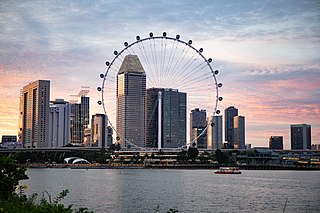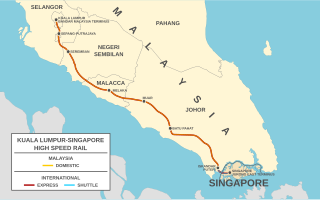Related Research Articles

Jurong is a geographical region located at the south-westernmost point of the West Region of Singapore. Although mostly vaguely defined, the region's extent roughly covers the planning areas of Jurong East, Jurong West, Boon Lay, and Pioneer, along with Jurong Island in the Western Islands cluster and the southernmost portions of the Western Water Catchment. Should it be described at its greatest historical extent, the region can also include present-day Bukit Batok and Tuas as well. Jurong also covers several offshore islands as well, including Pulau Damar Laut and Pulau Samulun, both of which are located within the planning areas of Jurong East and Boon Lay respectively; along with the aforementioned Jurong Island. The coastline of the region on mainland Singapore, faces the strait of Selat Jurong, while the southernmost island of the region, Jurong Island, faces the strait of Selat Pandan.

The East West line (EWL) is a high-capacity Mass Rapid Transit (MRT) line operated by SMRT in Singapore, running from Pasir Ris station in the east to Tuas Link station in the west, with an additional branch between Changi Airport and Tanah Merah stations. It is the second Mass Rapid Transit line to be built in Singapore. The 57.2 kilometres (35.5 mi) line is the longest on the MRT network, with 35 stations, 8 of which are underground. The line is coloured green on the rail map.

The Port of Singapore refers to the collective facilities and terminals that conduct maritime trade and handles Singapore's harbours and shipping. It has been ranked as the top maritime capital of the world since 2015. Currently the world's second-busiest port in terms of total shipping tonnage, it also transships a third of the world's shipping containers, half of the world's annual supply of crude oil, and is the world's busiest transshipment port. It had also been the busiest port in terms of total cargo tonnage handled until 2005 when it was surpassed by the Port of Shanghai.

Tuas is a planning area located within the West Region of Singapore. It is bounded by the Western Water Catchment to its north, Pioneer to its east and the Straits of Johor to its west. Tuas also shares a maritime boundary with the Western Islands planning area to its east.

The Pan Island Expressway is the oldest and longest expressway in Singapore. It is also Singapore's longest road. The expressway runs from the East Coast Parkway near Changi Airport in the east to Tuas in the west and has a total length of 42.8 kilometres (26.6 mi).

JTC Corporation (JTC), formerly the Jurong Town Corporation, is a statutory board under the Ministry of Trade and Industry that champions sustainable industrial development. It masterplans clean, green and smart estates to create attractive destinations for Singapore's talent and communities. The agency also drives innovations in the building and infrastructure sector.
Water supply and sanitation in Singapore are intricately linked to the historical development of Singapore. It is characterised by a number of achievements in a challenging environment with geographical limitations. Access to water in Singapore is universal, affordable, efficient and of high quality.

This article shows the notable future developments in Singapore. Majority of them are currently under construction with most to be completed within the next five years.
The Public Utilities Board (PUB) is a statutory board under the Ministry of Sustainability and the Environment of the Government of Singapore responsible for ensuring a sustainable and efficient water supply in Singapore.

The Kuala Lumpur–Singapore high-speed rail (HSR) was a proposed railway project to link Kuala Lumpur, Malaysia to Singapore via a high-speed rail line. It was first proposed by then Malaysian prime minister Najib Razak in September 2010. Singapore prime minister Lee Hsien Loong formally agreed to the joint project in February 2013, with the HSR originally expected to be completed by 2026.

Gul Circle MRT station is an elevated Mass Rapid Transit (MRT) station on the East West line (EWL). Located in Tuas, western Singapore, the station serves the surrounding industries of JTC Space @ Tuas and Mapletree Pioneer Logistic Hub. The station is operated by SMRT Trains.
Tuas Power Ltd is one of the largest power generation companies and a key provider of energy solutions, multi-utilities and environmental services in Singapore.
The following lists events that happened during 2015 in the Republic of Singapore.

The Transboundary Haze Pollution Act 2014 (THPA) is a statute of the Parliament of Singapore that criminalizes conduct which causes or contributes to haze pollution in Singapore, and to provide for related matters such as deterrence. The law is designed specifically to allow legal in suing companies for environmental pollution.
The following lists events that happened during 2018 in the Republic of Singapore.
The Greater Southern Waterfront is a major waterfront project under development situated in southern Singapore, straddling its coastline. At present, the area is occupied by the Tanjong Pagar and Brani terminals of the Port of Singapore, which will be progressively moved to the Tuas Megaport, as well as Keppel Golf Club. The GSW will span 30 kilometres across the southern coastline of Singapore when fully completed.
The following lists events that happened during 2019 in the Republic of Singapore.

Senoko Energy is a Singaporean electric utility company and retailer. It is the largest power generation company in Singapore, accounting for approximately 20% of the nation's electricity supply. It also operates the Senoko Power Station, the nation's largest power plant by generation capacity. Since 2008, it has been owned by Lion Power, a consortium led by Japanese trading company, Marubeni.
The following lists events that happened during 2021 in the Republic of Singapore.
References
- ↑ Soh, Andrea (12 April 2016). "PUB to study feasibility of desalination plant on Jurong Island". The Business Times . Singapore. Retrieved 6 May 2022.
- ↑ Soh, Andrea (13 April 2016). "PUB exploring feasibility of desalination plant on Jurong Island: Masagos". The Business Times . Singapore. Retrieved 6 May 2022.
- ↑ Siau, Ming En (12 April 2012). "Climate change forces S'pore to look at 5th desalination plant, in Jurong". today . Singapore. Retrieved 6 May 2022.
- ↑ "Consortium picked for fifth desalination plant". tabla! . Singapore. 15 July 2016.
- ↑ Khew, Carolyn (12 July 2016). "Singapore to build fifth desalination plant on Jurong Island". The Straits Times . Singapore. Retrieved 6 May 2022.
- ↑ "Proposal for Singapore's fifth desalination plant awarded to Tuas Power – Singapore Technologies Marine Consortium". PUB. 27 September 2017. Retrieved 6 November 2022.
- ↑ Zaccheus, Melody (27 September 2017). "Tuas Power-ST Marine consortium picked as preferred bidder to build fifth desalination plant on Jurong Island". The Straits Times. Retrieved 6 November 2022.
- ↑ Zaccheus, Melody (28 September 2017). "Consortium picked for fifth desalination plant". The Straits Times . Singapore. Retrieved 6 May 2022.
- ↑ Ang, Qing (17 April 2022). "S'pore's fifth desalination plant opens on Jurong Island". The Straits Times . Singapore. Retrieved 6 May 2022.
- ↑ Tan, Ashley (18 April 2022). "S'pore opens 5th desalination plant on Jurong Island". Mothership.sg . Retrieved 2 May 2022.
- ↑ Ang, Qing (18 April 2022). "How just 2 people can run plant that produces up to 30m gallons of water daily in Singapore". The Straits Times . Singapore. Retrieved 6 May 2022.
- ↑ Tang, See Kit (17 April 2022). "Singapore officially opens fifth desalination plant which is 5% more energy efficient". CNA . Singapore. Retrieved 6 May 2022.